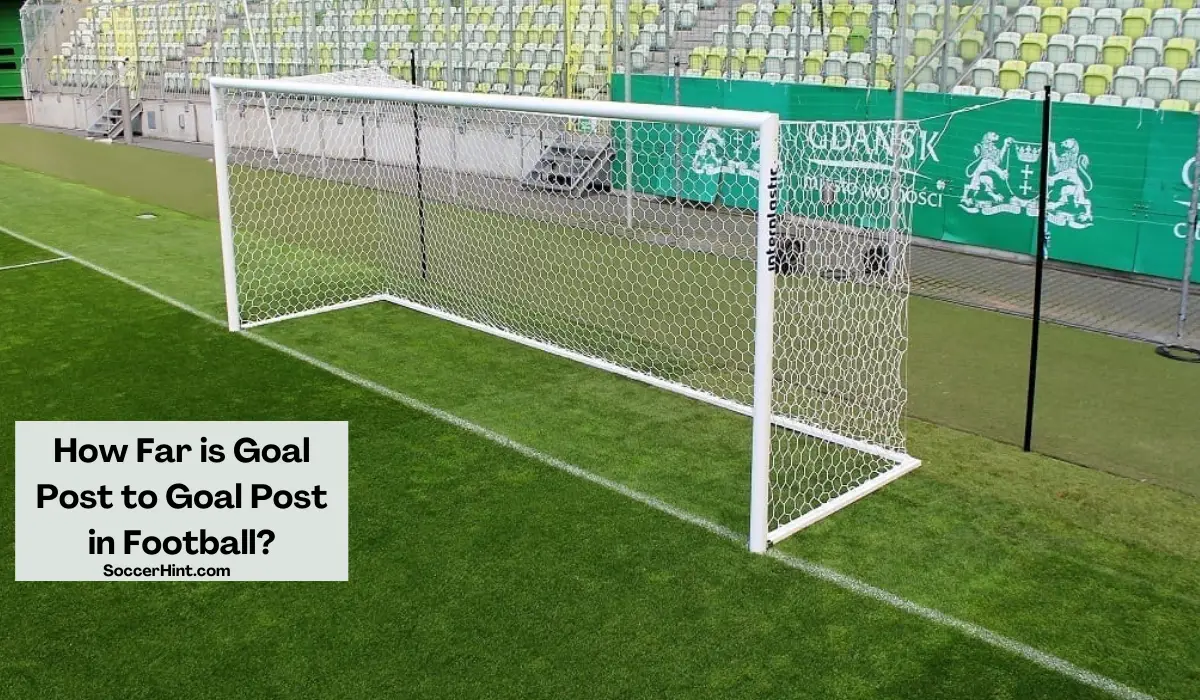The distance between football goal posts is more than just a stretch of field; it’s a focal point that sparks curiosity among fans. Many wonder just how far it is from one goal post to the other, and this seemingly simple question carries significant meaning.
Understanding this distance isn’t just about satisfying curiosity; it reveals insights into the essence of the game. Football fans seek answers because it helps us appreciate the strategic state of play and the physical demands placed on players as they play on the pitch.
This article explains why this topic matters, exploring why football fans are drawn to understanding the field’s dimensions.
Read Also: What Is a Goal Post Made of?
The Actual Distance Between Goal Posts In Football
In Football, the distance between one goal post to another is essentially the length of the entire football pitch. This measurement spans the width of the field, from one end to the other, encompassing both goal posts at either end.
The standard length of a soccer pitch varies but typically falls within the range of 100 to 130 yards (90 to 120 meters). This distance includes the space between the two goal posts, forming the entirety of the playing surface where teams compete to score goals and ultimately win the match.
Understanding the distance between goal posts provides a better knowledge of the playing field and the challenges faced by players as they play its length. It also highlights the significance of scoring goals, as teams strive to advance the ball across this distance to reach the opposing team’s goal post.
Read Also: Why Goal Post Is Called Woodwork
How Length Of Soccer Pitches Evolved Over Time
Over time, the size of soccer pitches has changed a lot. In the beginning, when people played on streets and open spaces, there weren’t strict rules about how big the field should be. It could vary a lot from place to place.
As soccer became more organized and popular, people realized they needed consistent rules for the size of the pitch. That’s where organizations like FIFA came in. They made rules that everyone had to follow about how long and wide a soccer field should be. This helped make the game fair and consistent no matter where it was played.
So, from the early days of playing wherever there was space to the present with official rules set by organizations like FIFA, the size of soccer pitches has come a long way, making the game more structured and fair for everyone involved.
International Variations About Soccer Pitches Size
Soccer fields can vary in size depending on where you are in the world. For instance, in England, Premier League stadiums often have larger pitches compared to those in Spain’s La Liga. One notable example is Arsenal’s Emirates Stadium in London, which has a pitch size of around 105 meters by 68 meters, while Barcelona’s Camp Nou measures approximately 105 meters by 68 meters.
These differences in size can significantly impact gameplay. Players have more space to manoeuvre on a larger pitch and create scoring opportunities, leading to fast-paced, attacking football. In contrast, smaller pitches, like those found in Italy’s Serie A, can result in more congested play, with teams relying on tight defensive formations to restrict their opponents’ movements.
Furthermore, within the same league, pitch sizes can vary between stadiums. For instance, in the English Championship, the home ground of Queens Park Rangers, Loftus Road, has one of the smallest pitches at 100 meters by 64 meters, while the pitch at Aston Villa’s Villa Park measures 105 meters by 68 meters.
These variations in pitch dimensions add an extra element of strategy, as teams must adapt their playing style to suit the specific size of the field they are competing on.
Possible Future Trends of Football Fields
Looking ahead, there are exciting possibilities for how soccer pitches might change. One idea is that new technologies could make pitches more durable and easier to maintain. This means they could stay in better condition for longer, providing a better playing surface for teams.
Another trend could be a focus on sustainability. This might involve using eco-friendly materials for pitch construction or implementing systems to recycle water used for irrigation. By being more environmentally friendly, soccer pitches can contribute to a healthier planet.
Player preferences also influence future pitch designs. For example, players may prefer surfaces that offer better traction and shock absorption, reducing the risk of injuries. So, future pitches could be designed with these factors in mind to enhance player safety and performance.
Essentially, as technology advances and concerns about sustainability grow, we may see soccer pitches evolving to meet these changing needs and preferences, ensuring the beautiful game can be enjoyed for generations to come.
Conclusion
When someone asks, “How far is the goal post to goal post?”, the correct answer is 100 to 130 yards (90 to 120 meters). In football, the distance between goal posts encapsulates the entire length of the field, reflecting the journey teams undertake in pursuit of victory.
From the historic origins of open-field play to the standardized regulations enforced by organisations like FIFA, the evolution of soccer pitch dimensions has been remarkable. International variations in pitch sizes, ranging from 100 to 130 yards in length, contribute to the diverse strategies and gameplay observed across different leagues and countries.
Looking forward, future trends promise innovations that could reshape soccer pitches, with advancements in technology and sustainability initiatives leading the way. However, amidst these changes, the fundamental essence of soccer remains unchanged—the pursuit of excellence across the expanse of the pitch, from one goal post to the other, a distance representing the challenges, triumphs, and timeless allure of the beautiful game.





